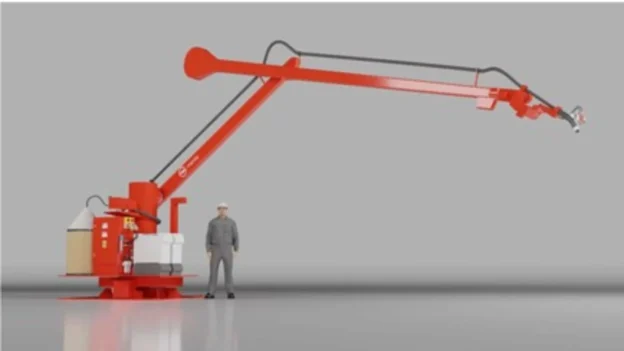FBR Limited has officially introduced Mantis™, its new welding robot designed to meet the demands of heavy industry. This automated robotic welding system incorporates Dynamic Stabilisation Technology (DST), a patented solution previously applied on the Hadrian X masonry robot.
Mantis™ becomes the Australian company’s second major commitment to large-scale automation.
How the Mantis™ welding robot operates
With an operating range of 8 meters and the ability to weld up to 25 kilograms per hour, Mantis™ is targeted at industries such as mining, shipbuilding and defense. The configuration can be adapted to different working environments, either using a standard welder or with dual wires for high deposition rates. In addition, its head incorporates a laser scanner that identifies and tracks seams, improving quality on parts with dimensional variability.
The robot head incorporates a laser scanner that identifies and tracks seams. Source: FBR
The system is programmed with the Australian platform Verboticswhich allows welding tasks to be planned and simulated prior to field execution. This functionality helps benchmark performance against other robots or manual processes, giving fabricators a productivity and accuracy advantage.
More details on design and price
Unlike retrofitted six-axis robotic arms, Mantis™ has been designed from the ground up for high-volume welding operations. Its architecture, combined with DST technology, minimizes part handling and reduces system complexity. This results in fewer points of failure and more efficient operation in variable environments.
FBR plans to sell the units directly, including agreements with distributors and business partners. The starting price is A$990,000, with customized integration and support options. The first unit is scheduled to be manufactured in fiscal 2026, while discussions continue to close partnerships to accelerate its arrival to market.
With Mantis™, FBR reaffirms its strategy to expand the application of its intellectual property beyond the construction sector. The objective is to address critical bottlenecks such as low productivity and labor shortages in industrial sectors.
Follow us on social networks and don’t miss any of our publications!
YouTube LinkedIn Facebook Instagram X (Twitter) TikTok
Source and photo: FBR Limited

